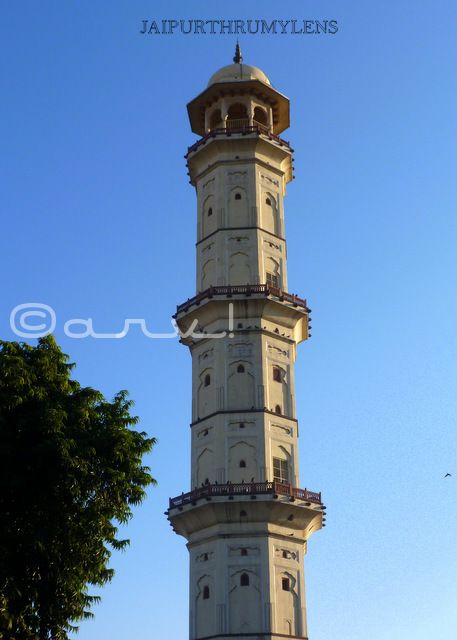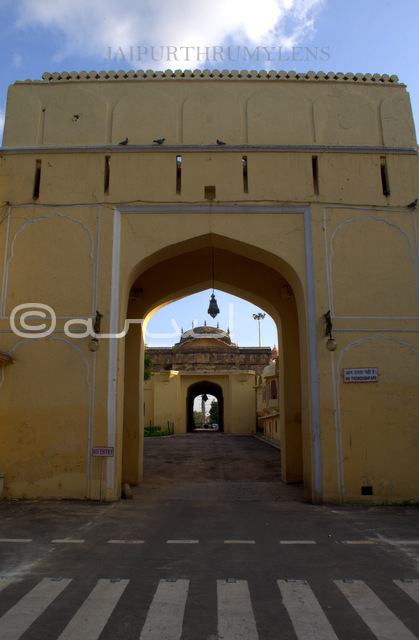I started Jaipur then and now series from last year to show the transformation and change of major milestones over the years. It has been a long time since I last wrote a post in this series. I have already written 4 posts in this series – Galta Gate, Hawa Mahal, Chauti Chaupar and Galta Temples. Going forward, this message is on Tripolia Gate. Tripolia Gate is an important landmark of Tripolia Bazar apart from Sargasuli. Tripolia Bazar owes its name to this gate. It is one of the two major ports of City Palace of Jaipur – the royal residence and is located on the southern edge.
Here’s an old photo of Tripolia Gate.
It’s an undated photo. I have no idea about the photographer but I assume this must be early 1940’s as there is a cyclist in the picture.
Tripolia means three wrists. Pol means arched gate. This gate takes its name from the three Pols. All major old city gates of Jaipur have three different Pols. They are grouped together, with the middle Pol being the largest of the three. In this particular design, the Pols are part of one structure. The smaller wrists are more of a decorative element. I have already written a post about Pols variety in Jaipur. You can read this post by clicking on this link – Jaipur Pol (Jaipur Gates)
Now compare this to the current photo.

There are significant changes in the structure of the Tripolia Gate.
Small Jharokas or lattice windows are not present in the old photo. The barred screen can only be seen on one side. According to the available information, these Jharokas were built by Maharajah Sawai Man Singh II, the last ruler of Jaipur. It must have been a beautification ride. These grilles allowed the royal ladies to witness the procession without appearing in public.
There is a gas lamppost on either side of the gate in the old photo, which is missing in the new photo. They were imported from England during the reign of Maharaja Sawai Ram Singh II and installed in important places in the city. It’s hard to find these original heritage lampposts in the city. These were installed before electricity supply started in Jaipur. The government has installed the replica in many places, including the historic walkway in Jaipur and Ram Niwas Garden, but it is no match for the original design. In the current photo, the high mast light is an eyesore. I often wonder why we allow such things to be installed in the name of development. Why is aesthetics ignored? These heritage structures attract tourists to the city and we must ensure that the beauty of heritage structures is preserved.

The grille design has also undergone a change. Did I mention the storefront? The tarpaulin used to be used as an awning or awning, but now a shaded walkway has replaced the storefront. Two guns are placed in front of small gates. This is also a recent addition and adds to the port’s beauty.
Check out other posts in Jaipur then and now.
Stay tuned with Jaipurthrumylens!! through Facebook, Twitter, Instagram

Importance of Tripolia Gate
Tripolia Gate is not open to the public. It is used exclusively by members of the royal family. I must make a special mention of the historical and cultural importance of Tripolia Gate. All royal processions would pass from Tripolia Bazar, a tradition that continues to this day. Processions of the local festivals like Teej and Gangaur deserve a special mention. This gate leads to the Chandni Chowk of Jaipur City Palace on one side and Chaura Rasta on the other side. Chandni Chowk has a number of heritage temples such as Pratapeshwar Temple, Brijnidhi Temple and Anand Bihari Temple. Ahead is the famous UNESCO World Heritage Site of Jantar Mantar and the main entrance to the City Palace. Chaura Rasta is another major bazaar in the walled city area of Jaipur. Compared to Sirehdyodi entrance, Tripolia Gate is much smaller of the two, but its importance weighs the scale in its favor. On the other hand, visitors are not allowed through this gate.
Read Teej festival in Jaipur


